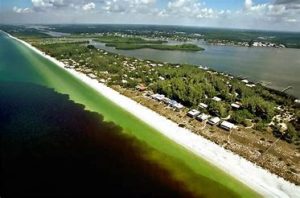16-months of beach heartache over

Red Tide Bloom off Florida’s Gulf Coast
Florida’s ongoing calamity from Mother Nature, known as Red Tide, has finally gone away. The naturally-occurring red algae hung around from the fall 2017 season all the way through 2018 and into last month, before finally abating. But not before it killed tons of fish, turtles, dolphins, and manatees, creating a smelly mess that impacted beaches – and tourism – up and down the west coast of Florida.
The Florida Fish and Wildlife Conservation Commission reports that the latest round of testing from the beginning of February shows Florida’s coastal waters are entirely free of the red tide algal blooms. The problem has plagued many beaches for the past 16 months, since October 2017.
Red tide blooms occur from higher than normal concentrations of a microscopic algae, Karenia Brevis, which release toxic chemicals that can affect marine life and people. People with respiratory illness have had to stay away from the beaches as a result, with others avoiding the coastline simply due to the bad smell. It hasn’t been the typical idyllic Florida beach scene, to say the least.
Tourism in Sarasota County fell significantly in the last quarter of last year, with hits as well in Manatee and Pinellas Counties to the north and Charlotte, Lee, and Collier Counties to the south. Parts of the Florida Panhandle as well as a few east coast beaches were impacted last summer as well.
The red tide killed almost 150 dolphins and hundreds of various specifies of fish, sea turtles, and manatees. Although red tide is typical in late fall most years, it doesn’t usually last this long. The last long-term outbreak in 2005-2006 lasted 17 months.
LMA Newsletter of 2-18-19

